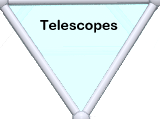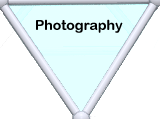Windows of Astronomy |
||
SpectroscopyA laboratory spectroscope is an instrument that spreads out the spectrum of a light source, typically by means of a prism or a diffraction grating. The idea for such an instrument was developed by the famous glass-worker Joseph Fraunhofer in the second decade of the 19th century. With his spectrometer he was able to see detail in the solar spectrum that isn’t visible in such naturally occurring phenomena as rainbows, detail that even Isaac Newton had missed during his experiments with prisms. As later spectroscopists found out, the detail was in the form of dark absorption lines, characteristic of the elements present in the outer layers of the Sun and characteristic of their state of ionisation. This work opened the window of stellar spectroscopy. Stellar spectroscopy turns out to be an astonishingly powerful tool. It achieves what nineteenth century philosophers and indeed non-astronomers thought would be impossible, namely telling what stars are made of. Through spectroscopy one can deduce the composition of a star, its temperature, the presence on its surface of strong magnetic fields, even its speed of movement towards or away from us and, for very distant objects, their rough distance away. This list is not exhaustive. Spectroscopy is in a way the astronomer’s microscope, revealing detail far beyond that accessible to our unaided senses. One unsung result of spectroscopy is that the stars for as far as we can see, and that is a very long way indeed, are made of the same elements and particles as are found on Earth. The strangeness of the heavens is the variety of ways these ingredients are organised, making Earth a rather special place. |
||
Since motion of a star has a small effect on the positions of its spectral lines, binary stars show a well-defined periodic motion of their spectral detail as they orbit each other. Many binaries ‘give themselves away’ by showing doubled spectroscopic lines even if we don’t see two stars. This allows the period of their orbit around each other to be deduced, the eccentricity of their orbits and at least the ratio of their masses. Since the mid-1990s, the same general technique applied to the lines from a single star has been used to detect orbiting planets. It is the most reliable technique for identifying ‘extra-solar planets’. There are broadly two spectroscopic techniques, both begun in the nineteenth century. Placing a large narrow-angle prism in front of the objective lens of a refracting telescope creates a spectrum for every object seen. Narrow angle prisms don’t have much dispersion so the spectrum does not show fine detail. Moreover, if many stars appear close together in the image, their spectra will overlap. Nonetheless, this method provides far more detail than simple observations of the colour of a star and enables stars to be classified into a range of types. At first the significance of the classification wasn’t apparent but in the twentieth century the classification was shown to be related to their temperature and to the evolution of stars over time. The second method is to place the spectrometer at the eyepiece end of the telescope and display and record the spectra of individual stars or galaxies. This can be done with spectrometers that give a much wider spread to the spectrum than objective prisms and hence show more detail. A development of this technique at the end of the twentieth century was to position fibre-optic receptors at the known position of stars or galaxies in the final image plane. The fibre-optics transmit the signal to individual channels in a display that records each spectrum digitally. In the twenty-first century version, many hundreds of spectra are obtained simultaneously as the telescope follows the rotation of one patch of sky and the fibre-optics are then manoeuvred under computer control when a new image is selected. It is this technique in particular that allows astronomers to plot the large-scale structure of the universe, for each distant galaxy in a field of view reveals how far away it is through the wavelength of its spectral lines. |
 Part of the field given by an objective lens prism. Colour is not necessary to see the spectral lines. Because of the spread of light by the prism, only brighter stars in the field show a clear spectrum. Part of the field given by an objective lens prism. Colour is not necessary to see the spectral lines. Because of the spread of light by the prism, only brighter stars in the field show a clear spectrum. |
|


